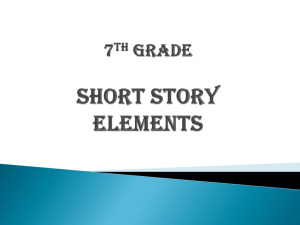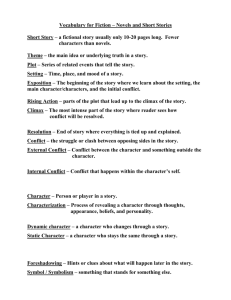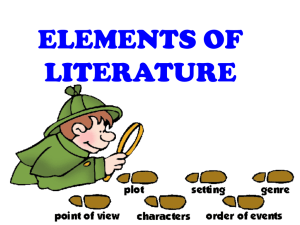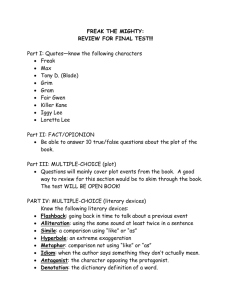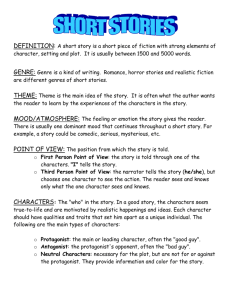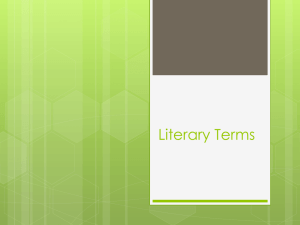Short Stories
advertisement
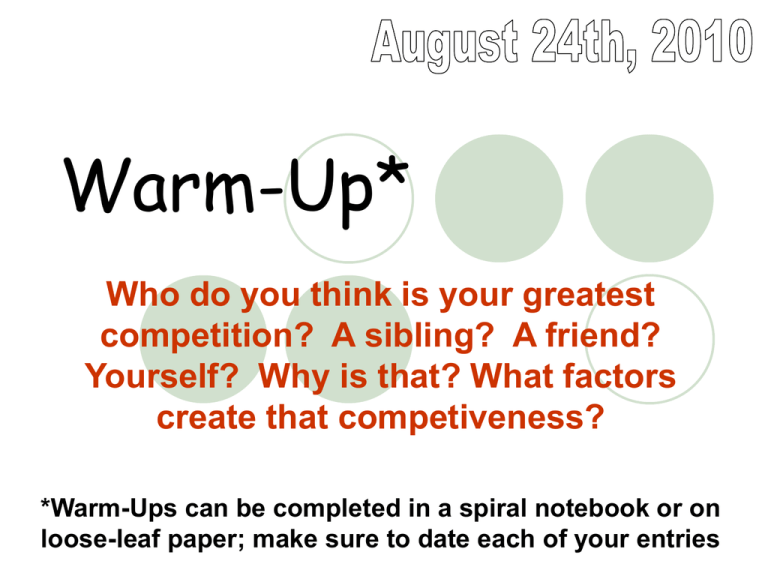
Warm-Up* Who do you think is your greatest competition? A sibling? A friend? Yourself? Why is that? What factors create that competiveness? *Warm-Ups can be completed in a spiral notebook or on loose-leaf paper; make sure to date each of your entries Warm-Up* Do you think teachers understand what is going on in the lives of their students? Why or why not? Elements of a Story Short Story Vocabulary PLOT - The plot is a planned, logical series of events having a beginning, middle, and end. A short story usually has one plot so it can be read in one sitting, while a play or novel could have many plots going on simultaneously. Short Story Vocabulary SETTING Tells the reader where and when the story takes place place - geographical location time - When is the story taking place? (historical period, time of day, year, etc) weather conditions - Is it rainy, sunny, stormy, etc? social conditions - What is the daily life of the character's like? mood or atmosphere - What feeling is created at the beginning of the story? 5 Essential Parts of Plot 1) EXPOSITION - The beginning of the story where the characters and the setting is revealed. 2) RISING ACTION - This is where the events in the story become complicated and the conflict in the story is revealed. 5 Essential Parts of Plot 3) CLIMAX - This is the highest point of interest and the turning point of the story. Everything changes. This often could be a final battle or life changing moment for our hero. The reader wonders what will happen next; will the conflict be resolved or not? the main character often receives and acts on new information in the climatic scene 5 Essential Parts of Plot 4) FALLING ACTION - The events and complications begin to resolve themselves. The story begins to wind down. 5) DENOUEMENT - This is the final resolution or “happily ever after” in the story. Short Story Vocabulary RESOLUTION – The story’s action after the climax THEME - controlling idea or central insight in a piece of fiction. It is the author's underlying meaning or main idea that he is trying to convey. The main lesson he or she is trying to get you to learn through the story. Often is a statement regarding human nature or life lessons Cannot be only one word (“triumph of the underdog”, “love conquers all”, “don’t be ashamed of who you are”) Short Story Vocabulary CONFLICT - It is the opposition of forces which ties one incident to another and makes the plot move. Conflict is essential to plot. Conflict is not merely limited to open arguments, rather it is any form of opposition that faces the main character. Within a short story there may be only one central struggle, or there may be one dominant struggle with many minor ones. Conflict There are two types of conflict: 1) External - A struggle with a force outside one's self. 2) Internal - A struggle within one's self; a person must make some decision, overcome pain, quiet their temper, resist an urge, etc. There are four kinds of conflict: 1) Man vs. Man (physical) - The leading character struggles with his physical strength against other men, forces of nature, or animals. 2) Man vs. Circumstances (classical) - The leading character struggles against fate, or the circumstances of life facing him/her. 3) Man vs. Society (social) - The leading character struggles against ideas, practices, or customs of other people. 4) Man vs. Himself/Herself (psychological) - The leading character struggles with himself/herself; with his/her own soul, ideas of right or wrong, physical limitations, choices, etc. Short Story Vocabulary POINT OF VIEW - the angle from which the story is told. 1. Innocent Eye - The story is told through the eyes of a child (his/her judgment being different from that of an adult) . 2. Stream of Consciousness - The story is told so that the reader feels as if they are inside the head of one character and knows all their thoughts and reactions. 3. First Person - The story is told by the protagonist or one of the characters who interacts closely with the protagonist or other characters (using pronouns I, me, we, etc). The reader sees the story through this person's eyes as he/she experiences it and only knows what he/she knows or feels. Short Story Vocabulary CHARACTER - The person in a work of fiction. Two types of characters: 1. PROTAGONIST - character is clearly central to the story with all major events having some importance to this character, the hero 2. ANTAGONIST - The opposition to the main character A Few More… Tone – The author’s feeling toward a subject, the characters, the scene, etc. “He uses a humorous tone when describing the child” Mood – The feeling created in the reader while reading the text, watching the movie, etc. “That book was really depressing!” A few more… Allusion – a reference to a mythological, literary, or historical person, place or thing. “Brad was such a Scrooge. He didn’t like to give any of his money away to serve other people in need.” “Until I see a burning bush I am not going to make any big decisions” “Do you think he’s pulling a Tiger Woods?” The Main Bits Elements of a Short Story: Plot 1. Setting 2. Characterization Climax 3. Plot 4. Conflict Rising Falling Action Action 5. Climax 6. Resolution 7. Theme 8. Point of View Setting Resolution 9. Tone Exposition Denouement 10. Mood “Be who you were born to be” What is the common theme? This movie makes me feel… Emotional Elated Stunned Empathic Nostalgic Entertained Sad What kind of conflict is this? Is this conflict internal or external? What type of conflict is this? Examples of _________ Examples of _____________ Partner Lit Terms Practice Track though each stage of the plot chart using a movie / book you both have seen. What happens in each scene? Climax Rising Falling Action Action (Setting) (Resolution) Exposition Denouement On the Back of Your Paper… Setting Protagonist / Antagonist Conflict (internal? external? which kinds?) What is the theme? What is the mood and tone of the story? Be prepared to share your plot chart after the test on Friday

